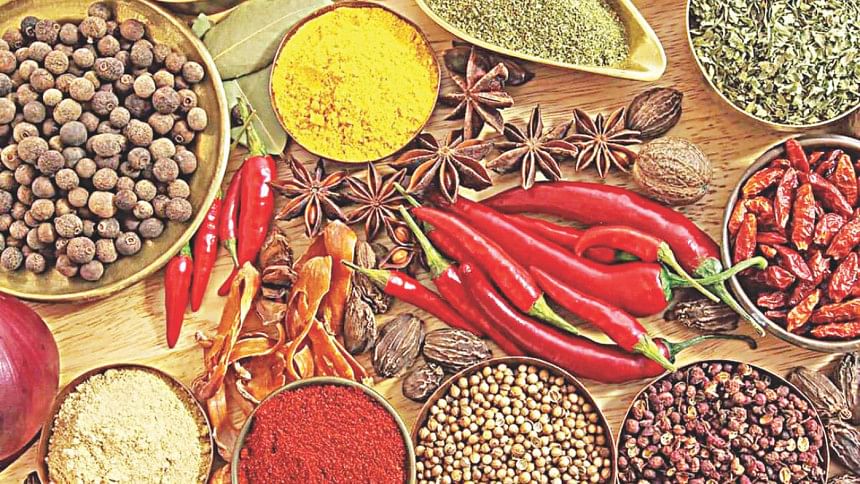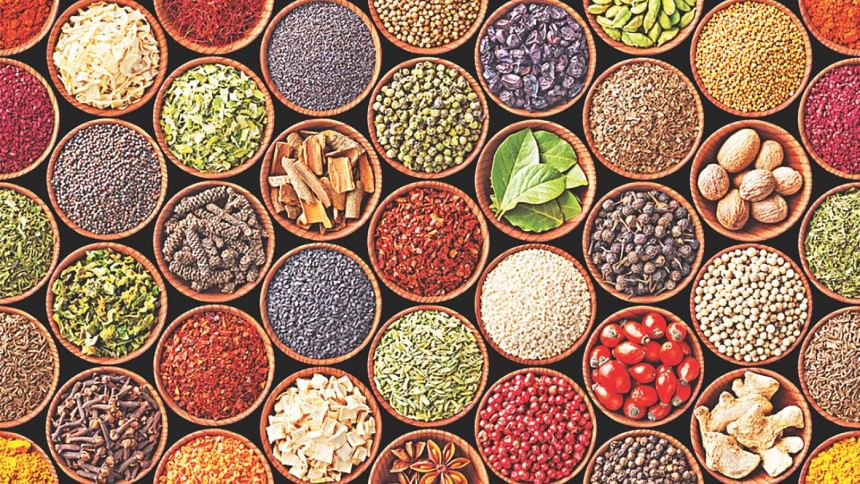The story of spices

Spice up your taste buds with healthy spices in your diet. According to the International Organisation for Standardisation, there is no clear-cut division between spices and condiments. The term spice or condiment applies to such natural plant or vegetable products or mixtures thereof, in whole or ground form as are used for imparting flavour.
Aromatic food substances which enhance flavour are spices and herbs. Spices are usually dried roots, barks or seeds used whole, crushed or powdered. Herbs are usually the fresh leaves, stems or flowers of herbaceous plants. Spices are also stronger than herbs.
Spices not only excite your tastebuds, but are composed of an impressive list of phytonutrients, essential oils, antioxidants, minerals, and vitamins that are essential for overall wellness. Spices have been integral part of our food for centuries, and have retained their relevance even to this day. It is all thanks to the Arab and European explorers, whose contributions in spreading them from their place of origin to the rest of the planet has immensely broadened their use and popularity all across the world.
In the culinary arts, the word spice refers to any dried part of a plant, other than the leaves, used for seasoning and flavouring a recipe, but not as the main ingredient. Why not the leaves you ask? That is because the green leafy parts of plants used in this way are considered herbs.
Every other part of the plant, including dried bark, roots, berries, seeds, twigs, or anything else that isn't the green leafy part, is considered a spice.
The history of spices is almost as old as human civilisation. It is a history of lands discovered, empires built and brought down, wars won and lost, treaties signed and flouted, flavours sought and offered, and the rise and fall and of different religious practices and beliefs. Spices were among the most valuable items of trade in the ancient and medieval times. Around 3500 BC, the ancient Egyptians were using various spices for flavouring food, in cosmetics, and for embalming their dead. The uses of spices spread through the Middle East to eastern Mediterranean and Europe. Spices have been closely connected to magic, culture, traditions, preservation, medicine and embalming since early in human history. Spices were a key component of India's external trade with Mesopotamia, China, Egypt and Arabia, along with perfumes and textiles -as far back as 7000 years ago- way before the Greek and Roman civilisations.
Spices can be categorized botanically according to their source of plant part as follows:
Leaves of aromatic plants: Examples include bay leaf, thyme, curry leaf etc.
Seeds: Examples include fennel, coriander, fenugreek, mustard, cumin, nutmeg dill, aniseed, celery etc.
Fruits: Examples include cardamom, cayenne pepper, black pepper, vanilla, all spice, tamarind etc.
Roots or bulbs: Examples include garlic, ginger, turmeric, galangal etc.
Bark: Cinnamon, cassia etc.
Flower: cloves are dried flower bud, also saffron, asafoetida etc
Arils, such as mace (part of nutmeg plant fruit).
SENSORY CHARACTERISTICS OF SPICES
Spices give aroma, colour, flavour and sometimes, even texture to food. Each spice or herb has specific unique chemical compounds that create these sensual qualities. Even casual cooks are probably able to identify the four most well-known flavour profiles -- bitter, salty, sour and sweet. When talking about spices, a true spice aficionado simply cannot be limited to just four or five. Spices usually do not have a single flavour profile.
Let's go through some most commonly used sensory characteristics when describing the flavours and aroma profile of spices. Saltiness is not included simply because flavour does not come from an individual spice in any capacity.
Bitter
Bitterness alone is not a good flavour for us as we are especially sensitive to it. Bitter flavours are usually considered an acquired taste, and they are present in coffee, chocolate.
Spices that are considered bitter are bay leaves, fenugreek seeds, horseradish, mace, cloves, lavender, ajwain, epazote, oregano, marjoram, peppercorns, thyme etc.
Cooling
Cooling spices are those that give the mouth a refreshed sensation. Some cooling spices include spearmint, dill, anise, fennel, sweet basil etc.
Earthy
These spices have an earthy flavour, which comes from presence of geosmin. Cumin, achiote (Annatto), and saffron are spices that have an earthy flavour.
Hot
Hot spices are those that add a strong flavour to the food and make it spicier. The hot flavour profile comes from the most exciting part of the flavour range. This flavour is characterised by its ability to heat up your mouth quickly, sometimes making food unbearable enough to leave you coughing. If your chilli is the right level of hot, you may find yourself crying as well. Pepper, chillis, mustard seeds, garlic, white pepper, and wasabi are all hot spices.
Sweet
This flavour is defined by how much sugar our tongue can discern in a food. Usually sweet foods are paired with sour or salty food. The contrasting flavours are pleasing to the human tongue and gives our brain a pleasing chemical reaction. Allspice, caraway, fennel, cardamom, nutmeg, poppy seeds, sesame seeds, star anise, and granulated honey are all considered as sweet spices.
Floral
These spices are those that give us the nice flavourful experience of the spring. You would more than likely associate this flavour with teas. Some floral spices include coriander, lemongrass, rose petals, saffron, sweet basil, thyme, lavender.
Nutty
Some people associate this flavour with almonds. Foods that are also associated with this flavour are cashews, peanuts and walnuts. There is almost something buttery about the nutty flavour. Some nutty spices include black cardamom, coriander seeds, poppy seeds, sesame seeds cumin seeds etc.
Pungent
Spices that fall under the pungent classification are strongly flavoured, and have strong aromatics as well. Some pungent spices include allspice, epazote, garlic, ginger, grains of paradise, marjoram, mustard, onion, paprika, dill seeds etc.
Sour
Sour flavours make your mouth pucker. Amchur, sumac and tamarind are some examples of sour spices.
Woody
Woody flavours are those that taste vaguely like wood. Sometimes, you will find coffee being described as woody, especially if the coffee beans are aged. Some woody spices include cinnamon, cardamom, clove, juniper, rosemary, Sichuan peppercorns.
GENERAL FUNCTIONS OF SPICES
Spices add flavour and colour to food, and make the food palatable and hence, the variety in the diet, cereals, pulses, vegetables or meat can be cooked in variety of forms due to the addition of different kinds of spices.
Spices in general stimulate salvation, acid secretion, and digestive enzyme. Spices increase the secretion saliva containing more of ptyalin so that food rich in carbohydrates are easily digested.
Some spices have anti-inflammatory, antibacterial, and antioxidant properties.
Some spices help in improving the impaired blood glucose levels in the body and help diabetics.

NUTRITIONAL VALUE AND HEALTH BENEFITS OF SPICES
Spices are used in small quantities to flavour dishes, meaning they add very few calories. This doesn't mean spices don't cause a large impact on your diet. They can be a great way to add necessary vitamins and minerals.
Spices contain an impressive list of plant-derived chemical compounds that are known to have disease preventing and health promoting properties. They have been used since ancient times for their anti-inflammatory, carminative properties. Let's take a look at some of the exciting benefits that many of the world's most popular spices have for our overall health.
Allspice
Allspice is a soothing, anti-inflammatory and carminative spice. Its benefits include reducing cancer, improving oral health, stimulating digestion, facilitating bone growth, and boosting the immune system. It also helps in reducing blood pressure and acts as an analgesic or anaesthetic substance.
Anise seeds
This powerful spice has antioxidants as well as a stomachic, anti-spasmodic, carminative, antiseptic, digestive and stimulant properties. It is a great source of vitamins and minerals like iron, potassium, copper and manganese. Anise seed helps increase the circulation and oxygenation of body parts while boosting the immune system and improving the quality of your skin.
Bay leaf
Bay leaf is a very popular spice throughout the world and is praised for its ability to prevent cancer, boost immunity, reduce neural tube defects, protect oral health, skin care, and hair care. It also helps improve nervous system function, regulate body metabolism, and prevent blood-related conditions like anaemia.
Cayenne pepper
Cayenne pepper has the ability to clear the sinuses, increase urination, eliminate toxins from the body, help manage diabetes, prevent cancer, and lower blood pressure. Use of cayenne pepper helps optimise the metabolism, regulate hormonal activity, and fight toxins and potential infections, due to its powerful antioxidant properties.
Capers
Capers prevent cancer, reduce illness, strengthen blood vessels, reduce clotting, lower cholesterol levels, and increase circulation. They also provide a huge wealth of vitamins like vitamin A, vitamin K, niacin, riboflavin, and minerals like iron and copper.
Caraway seeds
Caraway seeds improve digestion, reduce constipation, excess gas, neutralise free radicals, and prevent various diseases like cancer. These seeds provide vitamins like thiamine, pyridoxine, riboflavin and niacin. They also contain minerals like iron, copper, calcium, potassium, manganese, selenium, zinc and magnesium.
Black pepper
Black pepper is one of the most common spices in the world, packed with many health benefits. It can help reduce inflammation and excess gas, optimise gastrointestinal action, and regulate enzymatic reactions. Black pepper helps control heart rate and blood pressure.
Cinnamon
Cinnamon is praised for its ability to reduce inflammation, eliminate pain, manage diabetes, eliminate infections, reduce excess gas, and improve heart health. It also helps in increasing cognitive function, building strong bones and improving the health of eyes and skin.

Cardamom
The health benefits of cardamom include its ability to aid digestion, reduce spasms, lower blood pressure, increase the metabolism, improve circulation and increase frequency and volume of urination. It also provides the essential vitamins and minerals.
Cloves
Cloves have anti-microbial properties, which help in fighting oral diseases. They are also good for boosting the immune system.
Cumin
Cumin seeds are antioxidants, anti-inflammatory, and carminative by nature. They improve digestion, increase sperm count, build strong bones, improve eyesight, and prevent macular degeneration. Other benefits of cumin seeds include their ability to manage heart rate, lower blood pressure, act as a co-factor in many enzymatic reactions, increase red blood cell count, and prevent various types of cancer.
Garlic
Garlic is a great spice used to add a unique flavour to the food. It helps fight heart disorders, high blood pressure, cold, and cough.
Ginger
Largely known for aiding in digestion, ginger is a spice that exerts many benefits like preventing cancer, boosting the appetite, and improving respiratory conditions, among others.
Mace
Mace's properties include building strong bones, reduce depression, and insomnia. It also helps keep the skin healthy, boost hair health, and increase circulation to all parts of the body.
Mustard seeds
Mustard seeds are packed with organic compounds and volatile oils that can boost your overall health. They are also a wonderful source of B-complex vitamins, which are essential for normal functioning of your organs.
Nutmeg
Nutmeg is a great source of antioxidants, vitamins and minerals necessary for human health. It can fight fungal infections, work as an aphrodisiac, improve digestion, reduce excess gas, and improve hair and skin health. It also helps prevent macular degeneration and reduce the chances of developing cancer.
Important note: Nutmeg is poisonous when eaten in large quantities. It must always be stored well out of the reach of children. Two nutmeg seeds can be fatal to small children.
Saffron
Saffron contains many carotenoids and boosts immune system health in a big way. It also fights infections in wounds, elevates mood, induces sleep, stimulates red blood cell formation, and modulates hormonal activity.
Turmeric
Turmeric is best known for its anti-inflammatory properties. It aids in skin care, prevent cancer, eases menstruation, and detoxifies the body.
Vanilla beans
Vanilla beans contain a wide array of chemicals compounds and volatile oils, all of which have their own health benefits. However, studies done on vanilla beans have shown that they help control blood pressure, reduce heart rate, soothe nerves, regulate the body metabolism, induce sleep, and build strong bones.
HOW TO PURCHASE SPICES
You can judge the freshness of the spice by the colour and aroma. When fresh, most spices have a bright, rich colour and a strong aroma. Always purchase in small quantities to ensure that you are using fresh spices. Replace old spices once a year.
HOW TO STORE SPICES
A spice jar over the stove might be convenient, but because herbs and spices deteriorate when exposed to heat, light and moisture, it's not the most ideal place to keep them. The best storage temperature for herbs and spices is one that is fairly constant and below 70° Fahrenheit. This means products must be kept away from the furnace, stove and the heat of the sun.
While spices don't actually spoil or rot, they will lose their flavour over time. Keep your spices in tightly covered glass jars and store them in a cool, dry place. Whole spices stay fresh for up to 2 years while ground spices have a 6-month shelf life. Store red spices, such as paprika and red pepper, in the refrigerator. They will hold their colour and keep their flavour longer. Temperature fluctuations can cause condensation, and eventually, mould. If you store spices in the freezer or refrigerator, return them properly after use.
TIPS FOR COOKING WITH SPICES
Spices are key to creating delicious flavour in any kitchen. If you are concerned about eating healthy, spices are even more important. One thing to keep in mind when cooking with spices is that spices start to lose their flavour when they are ground. So whenever possible, it's best to grind our own spices immediately before using them.
Photo: Collected

 For all latest news, follow The Daily Star's Google News channel.
For all latest news, follow The Daily Star's Google News channel. 



Comments